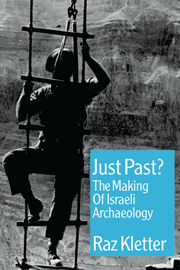Book contents
- Frontmatter
- Dedication
- Contents
- List of illustrations
- Introduction
- Acknowledgements
- Abbreviations
- 1 Archaeology and the 1948 War
- 2 Abandoned places, new places
- 3 Foreign aid
- 4 Frozen funds
- 5 A battalion of guards
- 6 Relief work
- 7 Man robs his land: “agreement” with General Dayan
- 8 “Gold of Ophir for Beth-Horon”: 3,000 shekels
- 9 The building beyond the border: the PAM, 1948–67
- 10 A building of dreams: a home for the IDAM and the origins of the Israel Museum, Jerusalem
- 11 A dead man on the council: the story of the supreme archaeological body in Israel
- 12 “But trust comes from the heart”: travels with the Government Tourist Corporation
- 13 “Whether in a courtyard of a synagogue, in a courtyard adjacent to a synagogue, or under a synagogue”: the Safad affair
- 14 The policy of salvage and early Israeli excavations
- 15 Myths and conclusions
- Appendix: other documents from the IDAM files
- Bibliography
- Author index
- Index
2 - Abandoned places, new places
- Frontmatter
- Dedication
- Contents
- List of illustrations
- Introduction
- Acknowledgements
- Abbreviations
- 1 Archaeology and the 1948 War
- 2 Abandoned places, new places
- 3 Foreign aid
- 4 Frozen funds
- 5 A battalion of guards
- 6 Relief work
- 7 Man robs his land: “agreement” with General Dayan
- 8 “Gold of Ophir for Beth-Horon”: 3,000 shekels
- 9 The building beyond the border: the PAM, 1948–67
- 10 A building of dreams: a home for the IDAM and the origins of the Israel Museum, Jerusalem
- 11 A dead man on the council: the story of the supreme archaeological body in Israel
- 12 “But trust comes from the heart”: travels with the Government Tourist Corporation
- 13 “Whether in a courtyard of a synagogue, in a courtyard adjacent to a synagogue, or under a synagogue”: the Safad affair
- 14 The policy of salvage and early Israeli excavations
- 15 Myths and conclusions
- Appendix: other documents from the IDAM files
- Bibliography
- Author index
- Index
Summary
When weapons operate muses are silenced, but not excavators… From ruins, broken vessels and crumbs of the past that disappeared you draw the eternal spirit of man.
Minister of Labour Mordechai Ben-Tov (BIES15 (1949/50): 55)Two years, ten years, and passengers ask the conductor:
What place is this?
Where are we now?
I am the grass.
Let me work
Carl Sandburg (“Grass”, 1918)The war left hundreds of abandoned places in its wake. The huge wave of immigration in 1948–52 resulted in extensive development of new places. This chapter discusses how these affected budding Israeli archaeology.
ABANDONED PLACES
The reasons why so many Palestinian Arabs left during the 1948 War have been the subject of heated debate in recent years among historians and “new historians” (Morris 1987, 1994: 1–18; Bligh 1998: 123–4; Karmi & Cotran 1999; Gelber 2004). The facts are not disputed. Plan “D” of the Hagana (the organization that preceded the Israeli army) from February 1948, formulated by Yadin, among others, aimed to conquer enemy bases (i.e. villages), destroy them and deport the residents. However, it aimed at a limited number of what were considered to be military targets (Morris 1987: 61–3; Benvenisti 2000: 108–10; Golan 2001: 204; Tovi 2002: 18). Shortly after the event, major Israeli leaders of the period spoke of the departure of the Arabs as an unexpected miracle (Fischbach 2003: 7–8).
- Type
- Chapter
- Information
- Just Past?The Making of Israeli Archaeology, pp. 42 - 81Publisher: Acumen PublishingPrint publication year: 2006



